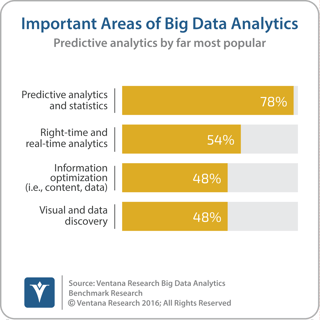Big data initially was characterized in terms of “the three V’s,” volume, velocity and variety. Nearly five years ago I wrote about the three V’s as a way to explain why new and different technologies were needed to deal with big data. Since then the industry has tackled many of the technical challenges associated with the three V’s. In 2017 I propose that we focus instead on a different letter, which includes these A’s: analytics, awareness, anticipation and action. I’ll explain why each is important at this stage of big data evolution.
Analytics
As with all technology investments, the ultimate objective in adopting big data should be to improve organizational processes and outcomes. Analytics can help users derive value from the data they collect. In short, the guidance that analytics can provide is what drives the need for big data. More data can enable more complete, accurate analysis. In the context of big data, analytics requires data science. In our big data analytics benchmark research more than three-quarters of organizations reported that predictive analytics and statistics is the most important area of big data analytics. Without big data capabilities it is not practical to browse billions of rows of data and expect to find all the important pieces of information hidden there.
Awareness
Big data analytics can identify previously unknown correlations and confirm expected relationships in the data. In either case, users need to be aware of those correlations. Business intelligence and visualization tools can help, but broader awareness can be created with tools that reach a wider audience and are more easily understood by nontechnical business users. Collaboration capabilities and alerts, especially those delivered via mobile devices, have the potential to keep everyone in the organization more informed. Natural-language generation – delivering observations via narrative – can be understood by nearly anyone.
Anticipation
Anticipation via predictive analytics gives organizations the opportunity to react to situations before they arise and offers the potential to capitalize on revenue opportunities or avoid significant expenses. In the same way that self-driving cars use big data analytics to anticipate what is happening ahead of them on the road to avoid accidents, organizations can anticipate how customers, products, machines, employees or even competitors might behave in a given situation to navigate their way through the markets in which they operate.
Action
Armed with awareness of correlations and anticipating behaviors organizations can take action. In some cases the action may be remedial, but in many cases people can take pre-emptive action to prevent unwanted behaviors such as customer churn or mechanical failure. They can also take action to encourage positive behaviors such as cross-selling or up-selling. In any case the action has to be embedded into operational processes, which requires capturing, analyzing and responding to streams of data in real time as they occur. Not all such actions will be automated. In those cases, collaboration tools can be used to engage employees and partners to review and carry out the recommended actions.
to streams of data in real time as they occur. Not all such actions will be automated. In those cases, collaboration tools can be used to engage employees and partners to review and carry out the recommended actions.
We mustn’t forget that big data still presents challenges to organizations that use it. For example, our predictive analytics research shows that preparing and accessing the data is hard: 62 percent of participants cited these as the biggest challenges in the data science behind big data analytics. Even more (79%) said that users don’t have enough skills to do their own data science analyses. At this stage it’s time to concentrate on the A’s of big data and build on the foundation represented by the V’s. Adopting this focus can help your organization understand why, whether and how to invest in big data. It will also help maximize the performance of your organization, which is the ultimate objective of such efforts.
Regards,
David Menninger
SVP & Research Director
Follow Me on Twitter @dmenningerVR and Connect with me on LinkedIn.











